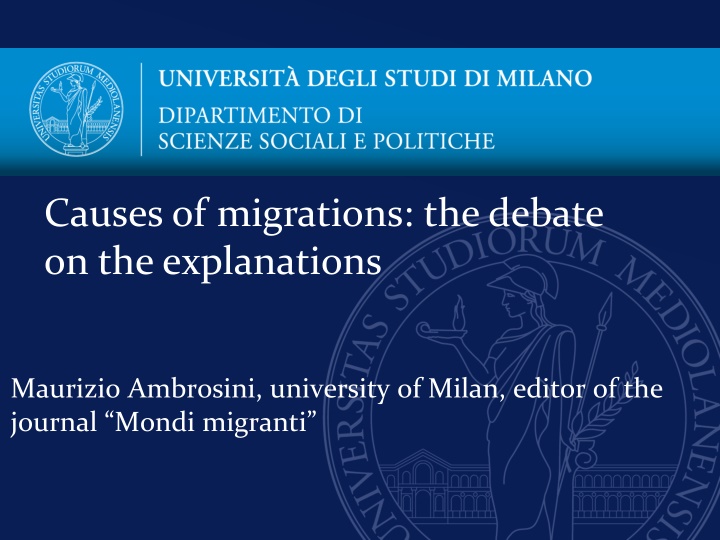Debates on Migration Causes: Macro vs. Micro Explanations
Causes of migration are debated between macro-structural and micro-subjective perspectives. Macro explanations focus on push factors like overpopulation and poverty, while micro explanations view migration as rational choices. The debate also includes meso-social factors such as migrant networks and political regulation. Criticisms of macro theories include neglecting autonomy of migrants. The link between poverty and emigration is explored, highlighting that most migrants come from intermediate countries with a middle-class background.
Download Presentation

Please find below an Image/Link to download the presentation.
The content on the website is provided AS IS for your information and personal use only. It may not be sold, licensed, or shared on other websites without obtaining consent from the author.If you encounter any issues during the download, it is possible that the publisher has removed the file from their server.
You are allowed to download the files provided on this website for personal or commercial use, subject to the condition that they are used lawfully. All files are the property of their respective owners.
The content on the website is provided AS IS for your information and personal use only. It may not be sold, licensed, or shared on other websites without obtaining consent from the author.
E N D
Presentation Transcript
Causes of migrations: the debate on the explanations Maurizio Ambrosini, university of Milan, editor of the journal Mondi migranti
Why migrations occur? 1) Macro-structural explanations. Push and pull factors. Expulsion and attraction. Supply and demand of migrants 2) Micro-subjective explanations. Migrations as rational choices of people and families 3) Meso-social explanations. Migrant networks and institutions. Political regulation (Macro-meso level)
Macro-structural explanation: the supply side Explanation based on push factors: demographic studies. Overpopulation, poverty, unemployment. Concept of migratory pressure Neo-marxist theories of dependency Globalization theories Systemic theories (various types of links)
Poverty and emigration There is a clear link between migration and inequalities in the economic development of the world But only very few migrants come from the poorest countries of the world There are 272 MLN of migrants in the world, 3.6 percent of world population They come mainly from intermediate countries (India, China ) Migrants do not come from the poorest social classes of their countries, even if there are differences between the nearer and the further countries Migration requires resources: economic, social, cultural capital Most of migrants have a middle class background
Macro-structural theories: the demand side Explanations based on pull factors: The demand by the economic systems of receiving countries Marxist theory of migrants as reserve army The dual labour market theory (M.Piore) The global cities theory (S.Sassen)
Criticisms of the macro-structural explanations Migrants are considered as passive victims: they move around the world because of structural, overwhelming forces Autonomy and agency of migrants are neglected These theories do not explain why, among the people exposed to the same pressures, some leave, but many others do not leave The normative regulation is not considered
Micro-subjective explanations Explanations related to neo-classical economics: migrants as rational actors, as investors. They are considered individualistic, selfish, and they aim at maximizing their personal interest Economic reasons (income) as the main factors of migratory choices New economics of migrations: families as decision makers. Migrations always seen as rational choice, but taken by families and oriented towards the well-being of the whole family unit
Criticisms of the micro-subjective explanations Problems of completeness and transparency of information Choices of destination are not strictly connected with the best economic opportunities, they do not target only the richest countries Lack of consideration of non economic factors of migrations Even in this case, the normative regulation is neglected Different interests, visions and power inside migrant families (gender and generations matter)
Meso-social explanations Migrant networks: importance of connections among migrants, non migrants, potential migrants, as social bridges between the two shores of migratory movement. Migratory institutions: not only networks, but a large complex of actors, formal and informal agencies, non profit and for profit organizations, legal and even illegal organizations, that foster departure, passage, working insertion and settlement of migrants
Criticisms of meso-social explanations Networks well explain why migrations continue, not the reasons why they begin Again, the normative regulation is neglected Explanations based on networks emphasize the informal dimension They often overlook the negative aspects of networks Explanations based on institutions put together too many different things
Regulation: a meso-macro explanation Growing salience of agreements regulating human mobility Tightercontrol of political borders (above all, after 2001) Destination countries try to select migrants whom they consider more suitable oreasy to accommodate Irregularimmigration, greyareas of unclear legal status search for side doors as a result of tighterregulations Civic stratification of migrants: different statuses and rights laws and international
Criticisms of regulation theories They explain how migrations occur, but theydo notexplain why theyoccur Most of them do not take into account the side effects and consequences of normative (mainly, restrictions of mobility) the unintended regulation
Conclusion We need a multi-causal explanation: a single factor (orvariable) is not enough A general theory of migration is probably unsustainable: different depend ondifferentfactors We can identify a typical dilemma in social theory here: structure versus agency, and the search for bridges between them fluxes can























